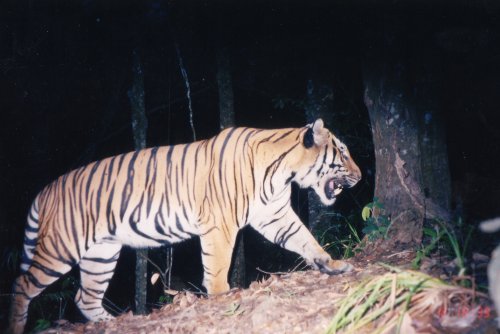Laos: The Tiger’s Last Home In Indochina
The only place in Indochina where tigers can naturally survive and breed outside zoos is in Laos, specifically in the Nam Et-Phou Louey National Protected Area where the continuing presence of the tiger testifies to the richness of the natural biodiversity in the area.
‘The last home for tigers in Indochina’ is a campaign designed to create awareness of the need for tiger protection in the Nam Et-Phou Louey National Protected Area (NPA).
According to the report of the World Bank’s Global Environment Facility, Nam Et-Phou Louey NPA has biological significance at the global, national, and local levels. The protected area is in a Class I Tiger Conservation Landscape and contains the last confirmed breeding population of Indochinese Tigers (Panthera tigris corbetti) outside of Thailand.
There have been no recent records of tigers in Cambodia and Vietnam, and just a few recorded sightings in China.
According to the Nam Et-Phou Louey NPA deputy head Mr Bouathong Xaiyavong, in a 2009 survey, through DNA checking, it is estimated that at least nine tigers including 2 female tigers remain in the park, which has good habitat with the potential of supporting breeding in the core area of over 300,000 hectares. In April this year, two tigers were photographed by camera traps and it is likely that more were there but not seen.
 |
|---|
|
Wildlife photographed using camera traps in the Nam Et-Phou Louey National Protected Area. –Photo Nam Et-Phou Louey website |
The NPA has a total land area of 420,000 hectares, of which 300,000 is maintained under extreme protection, covering eight districts in the three provinces of Huaphan, Xieng Khuang and Luang Prabang.
The Lao government and international organisations have been paying close attention and giving help and support in the fight to protect the big cat, in terms of providing funds and technical assistance.
Why is it important to protect the tiger?
The presence of tigers is not just a simple matter of their existence or non-existence in the forest. Tigers indicate the overall health of the ecosystem, as only the healthiest of these can support enough of the smaller animals (deer, gaur, wild pigs and others) to feed this large carnivore.
Tigers in the wild are indicative of a bountiful territory which protects its genetic diversity, and is the guardian and indicator of healthy forests. The tiger is at the top of the food chain. Therefore, the presence of a population of healthy tigers indicates healthy forests.
The tiger is an umbrella species. Its protection automatically ensures the conservation of a large number of flora and fauna and entire ecosystems. The tiger thus becomes a symbol for the protection of all species and is therefore referred to as an apex predator, an indicat or of the ecosystem’s health.
Senior Environmental Specialist from the World Bank, Mr Jean Michel Pavy, said “The tiger is an apex predator in the jungle. The presence of tigers is a good indication that the ecosystem is healthy.”
“The objective is not only to protect the tiger, but the whole ecosystem. Every wild creature, the full range of animal and plant biodiversity and all living things are linked in nature and losing some might lead to the whole ecosystem becoming corrupt.”
“The tiger is an apex animal, and has roamed the earth for a very long time. It is one of the elder statesmen on earth, much more so than the human being, and the fact that its dwindling numbers have largely been caused by human influence is disrespectful and very sad,” he lamented.
The main threat to tigers comes from poaching, habitat loss and fragmentation and direct conflict with humans.
Tigers were once widespread throughout most of the forested areas across Laos, but today they have disappeared from many parts of the country due to direct killing, unsustainable over-harvesting of their prey, and the loss of habitat.
According to a National Tiger Action Plan report for Laos (2010 to 2020) of the Forestry Department, since 2005 tigers have only been identified by came ra trap photos and genetic analysis of scratch marks found in one area, the Nam Et-Phou Louey NPA, while the survival of tigers in other parts of Laos is assumed f rom reports of animal sightings but remains unconfirmed.
The report also shows that from 2003 to 2009, about 28 tigers were reported killed, of which 17 came from the Nam Et-Phou Louey National Protected Area.
To protect the tiger as well as the biodiversity of the NPA, a number of international organisations are helping, with the Wildlife Conservation Society (WCS) currently providing funding of about US$200,000 annually.
The World Bank recently stepped in to provide more support through the WCS and the possibility exists that more funds from the World Bank will be given in the next five years for the Lao government to improve the systems and operations related to the management of national protected areas in Laos, and to ensure the sustainability of the Nam Et-Phou Louey NPA.
Lao government officials are stepping up enforcement efforts to end the use of trip wire explosives which kill many animal species in the protected area. They are also working with local communities to reduce the ecological impact of grazing livestock on tiger turf.
According to WCS information, even though the sale of tiger parts is illegal, a hunter can receive thousands of dollars per cat. In 1920, there were an estimated 100,000 tigers in the wild. Today, their numbers hover in the low thousands.
According to the information in the National Tiger Action Plan, the price of a wild tiger ranges from US$10,000 to US$70,000 on the international market. From the protected area, tiger bones sold for up to US$ 11,500 in 2004. Tiger parts, such as skin, teeth and bones were one of the most-traded wildlife items recorded in Laos during the 1990s.
However, through the government, local authority and international support, there are regular wildlife conservation awareness campaigns for the villagers in Nam Et-Phou Louey NPA. Through ecotourism activities and the reward of tourists seeing a tiger, the villages will get paid about one million kip for each sighting from a fund that concerns other endangered animals as well. The villagers seem to see the value of wildlife for sustainable tourism but more participation in conservation work is needed.
As World Wildlife Conservation Day is coming up this month, more actions need to be taken for the future of wildlife, which is here on earth with us, not for us.
published with the permission of Vientiane Times


